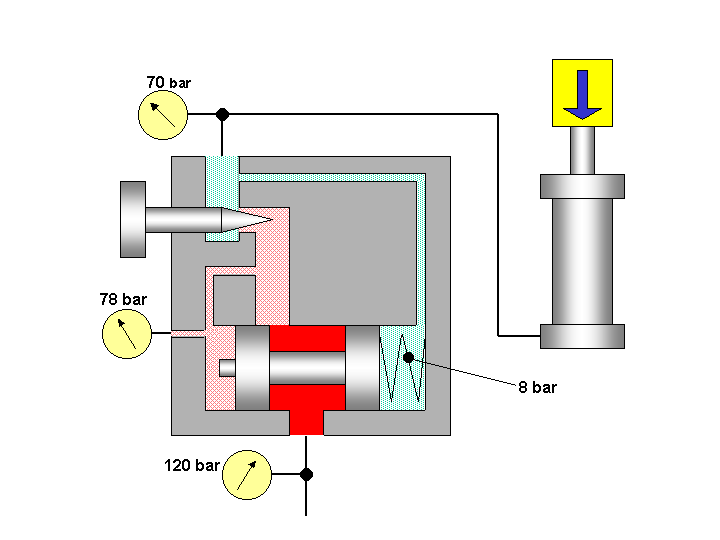
Controlling the velocity of a hydraulic cylinder by controlling the flow with a pressure compensated flow control
To control the velocity of a hydraulic motor or cylinder one has to control the flow to these components. This can be done with a simple flow control The flow is also determined by the construction of the flow control and by the viscosity of the fluid, but these factors are neglected.
Example: in a system with a flow control the pressure at the pump side is determined by the pressure relief valve (see also flow control). When the pressure drop across the flow control decreases as a result of an increase of the load on the cylinder the flow and velocity of the cylinder will decrease.
If the velocity has to remain constant and independent of the load one has to use a pressure compensated flow control
How does it work?
The flow through a flow control is determined by:
a) The area of the flow control: a larger area means a higher amount of flow and
b) the pressure drop across the flow control: an increase of the pressure drop means an increase of flow
The pressure at the outlet of the pressure compensated flow control is determined by the load on the cylinder. The load is 50 bar and increases to 90 bar when the mouse cursor is put on the picture. The pump pressure, determined by the pressure relief valve is 120 bar.
The pressure compensated flow control is adjusted on 10 l/min. The pump delivers 12 l/min: this means that the a flow of 4 l/min flows through the pressure control valve back to the reservoir.
The pressure compensated flow control in fact has two parts: a flow control valve (the needle valve) and a pressure reducing valve or pressure compensator. The desired flow is adjusted with the needle valve. The pressure compensator with spring loaded plunger at the left side measures the pressure at the inlet of the needle valve (p2). At the right side of the plunger the pressure of the load (p3) and of the spring are pushing the plunger to the left. The pressure of the spring is 8 bar.
The plunger finds it's balance when:
p2 = p3 + pspring ==>
p2 - p3 = pspring and because of the fact that pspring= constant (8 bar) the pressure compensator keeps the pressure drop across the needle valve on a constant value of 8 bar. This means that the flow through the needle valve remains constant!
When the load increases the pressure p3 increases and the plunger is out of balance and pushed to the left. Then the pressure p2 will increase as well and the plunger finds it's balance again. The pressure drop across the needle valve is still 8 bar so the flow remains 10 l/min and therefore the velocity of the cylinder remains constant and independent of the load!!